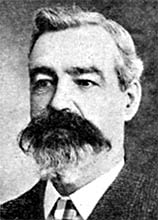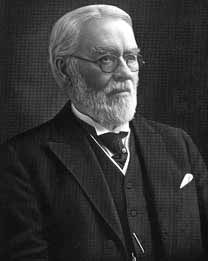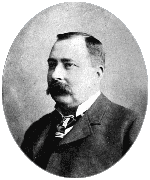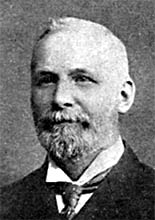INDUSTRIAL HAMILTON: A TRAIL TO THE
FUTURE
The Five Johns
John Dickenson - John Gibson
- John Moodie - John Patterson - John
Sutherland
John Dickenson
 John
Dickenson was born on August 4, 1847 in Northumberland, England. He came to
Canada when he was 11 years old and settled in Glanford Township with his family.
Following in his father's footsteps, John became a stone mason and later on
owned a brick works in Glanford. He went on to become a contractor, building
schools in Wentworth County as well as part of the Ontario Hospitals in Hamilton
and MimiCompany Besides constructing buildings, John's firm also paved roads laying
the first asphalt paving in Hamilton.
John
Dickenson was born on August 4, 1847 in Northumberland, England. He came to
Canada when he was 11 years old and settled in Glanford Township with his family.
Following in his father's footsteps, John became a stone mason and later on
owned a brick works in Glanford. He went on to become a contractor, building
schools in Wentworth County as well as part of the Ontario Hospitals in Hamilton
and MimiCompany Besides constructing buildings, John's firm also paved roads laying
the first asphalt paving in Hamilton.
John had a variety of interests which can be seen in the positions he held.
From 1893 to 1905 John represented South Wentworth in the Ontario Legislature.
He was the first manager of the Central Fair (held in Victoria Park) and the
planner and developer of the Hamilton Jockey Club. John was the president of
the South Wentworth Agricultural Society as well as the Pioneer Plowing Club.
He was also president of several businesses including the Hamilton and Brantford
Electric Railway and the Hamilton, Grimsby and Beamsville Electric Railway.
Similarly, John was director of the Hamilton and Barton Incline Railway.
John Dickenson died on January 4, 1932.
John Gibson
 John
Gibson was born on January 1, 1842 in the township of Toronto. He was the youngest
of seven siblings, having four brothers and two sisters. A few months after
his birth on April 5, John Gibson's father died. In 1851, the family moved to
the township of Oneida to live on a 200 acre farm. Instead of working on the
farm like his brothers and sisters, John attended school in Hamilton beginning
in 1853. John was very diligent and hardworking, consequently he was named Head
Boy of Central School and in 1859 was given the honour of turning on the water
for Hamilton's new waterworks. The same year he began attending the University
of Toronto, going on to receive numerous scholarships including the Prince of
Wales Prize. During his stay at university, John decided to join the militia
and upon returning to Hamilton in 1864 he transferred his membership to the
13th Battalion. In 1866 John was promoted to Lieutenant and fought against the
Fenians at the Battle of Ridgeway that same year. Thanks to his experience in
the military John was a renowned marksman. He represented Canada's rifle team
at Wimbledon in 1874, 1875, and 1879. John was with the 13th Battalion till
1895 and during this time he was promoted to Commanding Officer.
John
Gibson was born on January 1, 1842 in the township of Toronto. He was the youngest
of seven siblings, having four brothers and two sisters. A few months after
his birth on April 5, John Gibson's father died. In 1851, the family moved to
the township of Oneida to live on a 200 acre farm. Instead of working on the
farm like his brothers and sisters, John attended school in Hamilton beginning
in 1853. John was very diligent and hardworking, consequently he was named Head
Boy of Central School and in 1859 was given the honour of turning on the water
for Hamilton's new waterworks. The same year he began attending the University
of Toronto, going on to receive numerous scholarships including the Prince of
Wales Prize. During his stay at university, John decided to join the militia
and upon returning to Hamilton in 1864 he transferred his membership to the
13th Battalion. In 1866 John was promoted to Lieutenant and fought against the
Fenians at the Battle of Ridgeway that same year. Thanks to his experience in
the military John was a renowned marksman. He represented Canada's rifle team
at Wimbledon in 1874, 1875, and 1879. John was with the 13th Battalion till
1895 and during this time he was promoted to Commanding Officer.
Besides keeping order, John also had an interest in law. In 1870, he entered
into a law partnership with Francis Mackelcan. Two years later they were appointed
city solicitors and in 1890 John was to become Queen's Counsel. In 1899 John
was made a Bencher of the Law Society of Upper Canada.
 John
became attracted to politics in the 1870's. Starting as Hamilton's Reform candidate
in 1879, John would win that election and go on to acquire increasingly important
titles. John was appointed Provincial Secretary ten years later, and it was
in this position that he helped to pass the Children's Protection Act of 1893.
In 1896 John became the Commissioner of Crown Lands and in 1899 he was chosen
to be the Attorney General of Ontario. In 1908 John attained the position of
Lieutenant-Governor of Ontario which he held until 1914. During this time he
was also knighted.
John
became attracted to politics in the 1870's. Starting as Hamilton's Reform candidate
in 1879, John would win that election and go on to acquire increasingly important
titles. John was appointed Provincial Secretary ten years later, and it was
in this position that he helped to pass the Children's Protection Act of 1893.
In 1896 John became the Commissioner of Crown Lands and in 1899 he was chosen
to be the Attorney General of Ontario. In 1908 John attained the position of
Lieutenant-Governor of Ontario which he held until 1914. During this time he
was also knighted.
In addition to having held political positions of leadership, John Gibson was
president of several companies. He was the first president of the Cataract Power
Company and subsequently was the president of the Hamilton Terminal Company,
the Hamilton and Brantford.
Electric Railway, and the Hamilton Street Railway until 1908. Additionally,
he was at one point the vice-president of the Hamilton Radial Electric Railway
as well as the president of the Hamilton Hotel Company. Finally, he became the
president of National Steel Car in 1914.
On June 3, 1929 John Gibson died of a stroke. He had a funeral with full military
honours at the Central Presbyterian Church in Hamilton.
John Moodie
 John
Moodie was born on September 21, 1832 in Scotland. He apprenticed as a cabinet-maker
in Newton-Stewart and then worked in Glasgow. John came to Canada in 1856 and
established a dry goods store in Hamilton. On the suggestion of a travelling
salesman, John and his two older sons imported hand-knitting machines and started
making underwear in 1888. They called their business the Eagle Knitting Company
and it became one of the largest mills of its kind in Canada. John was the first
treasurer of the Cataract Power Company and would later become its president.
John had the distinction of having Lake Moodie near St. Catherines named after
him.
John
Moodie was born on September 21, 1832 in Scotland. He apprenticed as a cabinet-maker
in Newton-Stewart and then worked in Glasgow. John came to Canada in 1856 and
established a dry goods store in Hamilton. On the suggestion of a travelling
salesman, John and his two older sons imported hand-knitting machines and started
making underwear in 1888. They called their business the Eagle Knitting Company
and it became one of the largest mills of its kind in Canada. John was the first
treasurer of the Cataract Power Company and would later become its president.
John had the distinction of having Lake Moodie near St. Catherines named after
him.
John Moodie died in 1902. At his death, John was one of the wealthiest people
in Hamilton with an estate worth $1,117,000.
John Patterson
 John
Patterson was born on March 13, 1857 in County Tyrone, Ireland. His family moved
to Hamilton in 1867 where he attended Central School for a year. He got his
first job at the age of 12 and left home at 14. Initially, he worked at the
law office of Martin and Ferguson but moved on to the Wanzer
Sewing Machine Company, E. & C. Gurney, and
Spring Brewery.
John
Patterson was born on March 13, 1857 in County Tyrone, Ireland. His family moved
to Hamilton in 1867 where he attended Central School for a year. He got his
first job at the age of 12 and left home at 14. Initially, he worked at the
law office of Martin and Ferguson but moved on to the Wanzer
Sewing Machine Company, E. & C. Gurney, and
Spring Brewery.
In the mid 1870's John moved to the United States to pursue the lumber industry
in Ohio and Illinois. However, he soon returned to Canada, and using the knowledge
he had gained he started a lumber and planing mill business with his brother
Thomas in 1878. Called Patterson Brothers, John's role in the business only
lasted until 1893 at which point he let Thomas run it himself. In 1896 John
came up with the idea for the hydroelectric power scheme which would eventually
become Dominion Power and Transmission. In 1887 John
got the endorsement of the city of Hamilton to build 300 coke ovens east of
the city limits. However, it wasn't until after he secured the rights to a soft
coal field in Pennsylvania in 1900 when he actually made use of those ovens.
In 1908, John established the Hamilton, Waterloo, and Guelph Electric Railway
Company but unfortunately the railway line was never achieved.
On January 26, 1913 John Patterson died. Though there was talk of erecting
a suitable memorial in honour of John's contributions to the city nothing was
done. However, his name lives on in a dead-end lane called Patterson Street
which runs east from Queen Street North in Hamilton.
John Sutherland
 John
Sutherland was born in 1852 in Halifax, Nova Scotia and was also educated there.
He was first employed by Cunard Steamship Company in Montreal and later on with
the Grand Trunk Railroad at Stratford, Midland,
and Niagara Falls. In the early 1890's John retired from the Grand Trunk Railroad
and came to Hamilton. He subsequently entered into the contracting business.
John
Sutherland was born in 1852 in Halifax, Nova Scotia and was also educated there.
He was first employed by Cunard Steamship Company in Montreal and later on with
the Grand Trunk Railroad at Stratford, Midland,
and Niagara Falls. In the early 1890's John retired from the Grand Trunk Railroad
and came to Hamilton. He subsequently entered into the contracting business.
Besides co-founding the Dominion Power and Transmission
Company, John had an interest in the National Gas
Company where he served on the board of directors. Additionally, he was
a member of the Hamilton recruiting league during World War I.
John Sutherland died on November 28, 1916.
 John
Dickenson was born on August 4, 1847 in Northumberland, England. He came to
Canada when he was 11 years old and settled in Glanford Township with his family.
Following in his father's footsteps, John became a stone mason and later on
owned a brick works in Glanford. He went on to become a contractor, building
schools in Wentworth County as well as part of the Ontario Hospitals in Hamilton
and MimiCompany Besides constructing buildings, John's firm also paved roads laying
the first asphalt paving in Hamilton.
John
Dickenson was born on August 4, 1847 in Northumberland, England. He came to
Canada when he was 11 years old and settled in Glanford Township with his family.
Following in his father's footsteps, John became a stone mason and later on
owned a brick works in Glanford. He went on to become a contractor, building
schools in Wentworth County as well as part of the Ontario Hospitals in Hamilton
and MimiCompany Besides constructing buildings, John's firm also paved roads laying
the first asphalt paving in Hamilton. John
Gibson was born on January 1, 1842 in the township of Toronto. He was the youngest
of seven siblings, having four brothers and two sisters. A few months after
his birth on April 5, John Gibson's father died. In 1851, the family moved to
the township of Oneida to live on a 200 acre farm. Instead of working on the
farm like his brothers and sisters, John attended school in Hamilton beginning
in 1853. John was very diligent and hardworking, consequently he was named Head
Boy of Central School and in 1859 was given the honour of turning on the water
for Hamilton's new waterworks. The same year he began attending the University
of Toronto, going on to receive numerous scholarships including the Prince of
Wales Prize. During his stay at university, John decided to join the militia
and upon returning to Hamilton in 1864 he transferred his membership to the
13th Battalion. In 1866 John was promoted to Lieutenant and fought against the
Fenians at the Battle of Ridgeway that same year. Thanks to his experience in
the military John was a renowned marksman. He represented Canada's rifle team
at Wimbledon in 1874, 1875, and 1879. John was with the 13th Battalion till
1895 and during this time he was promoted to Commanding Officer.
John
Gibson was born on January 1, 1842 in the township of Toronto. He was the youngest
of seven siblings, having four brothers and two sisters. A few months after
his birth on April 5, John Gibson's father died. In 1851, the family moved to
the township of Oneida to live on a 200 acre farm. Instead of working on the
farm like his brothers and sisters, John attended school in Hamilton beginning
in 1853. John was very diligent and hardworking, consequently he was named Head
Boy of Central School and in 1859 was given the honour of turning on the water
for Hamilton's new waterworks. The same year he began attending the University
of Toronto, going on to receive numerous scholarships including the Prince of
Wales Prize. During his stay at university, John decided to join the militia
and upon returning to Hamilton in 1864 he transferred his membership to the
13th Battalion. In 1866 John was promoted to Lieutenant and fought against the
Fenians at the Battle of Ridgeway that same year. Thanks to his experience in
the military John was a renowned marksman. He represented Canada's rifle team
at Wimbledon in 1874, 1875, and 1879. John was with the 13th Battalion till
1895 and during this time he was promoted to Commanding Officer. John
became attracted to politics in the 1870's. Starting as Hamilton's Reform candidate
in 1879, John would win that election and go on to acquire increasingly important
titles. John was appointed Provincial Secretary ten years later, and it was
in this position that he helped to pass the Children's Protection Act of 1893.
In 1896 John became the Commissioner of Crown Lands and in 1899 he was chosen
to be the Attorney General of Ontario. In 1908 John attained the position of
Lieutenant-Governor of Ontario which he held until 1914. During this time he
was also knighted.
John
became attracted to politics in the 1870's. Starting as Hamilton's Reform candidate
in 1879, John would win that election and go on to acquire increasingly important
titles. John was appointed Provincial Secretary ten years later, and it was
in this position that he helped to pass the Children's Protection Act of 1893.
In 1896 John became the Commissioner of Crown Lands and in 1899 he was chosen
to be the Attorney General of Ontario. In 1908 John attained the position of
Lieutenant-Governor of Ontario which he held until 1914. During this time he
was also knighted. John
Moodie was born on September 21, 1832 in Scotland. He apprenticed as a cabinet-maker
in Newton-Stewart and then worked in Glasgow. John came to Canada in 1856 and
established a dry goods store in Hamilton. On the suggestion of a travelling
salesman, John and his two older sons imported hand-knitting machines and started
making underwear in 1888. They called their business the Eagle Knitting Company
and it became one of the largest mills of its kind in Canada. John was the first
treasurer of the Cataract Power Company and would later become its president.
John had the distinction of having Lake Moodie near St. Catherines named after
him.
John
Moodie was born on September 21, 1832 in Scotland. He apprenticed as a cabinet-maker
in Newton-Stewart and then worked in Glasgow. John came to Canada in 1856 and
established a dry goods store in Hamilton. On the suggestion of a travelling
salesman, John and his two older sons imported hand-knitting machines and started
making underwear in 1888. They called their business the Eagle Knitting Company
and it became one of the largest mills of its kind in Canada. John was the first
treasurer of the Cataract Power Company and would later become its president.
John had the distinction of having Lake Moodie near St. Catherines named after
him. John
Patterson was born on March 13, 1857 in County Tyrone, Ireland. His family moved
to Hamilton in 1867 where he attended Central School for a year. He got his
first job at the age of 12 and left home at 14. Initially, he worked at the
law office of Martin and Ferguson but moved on to the
John
Patterson was born on March 13, 1857 in County Tyrone, Ireland. His family moved
to Hamilton in 1867 where he attended Central School for a year. He got his
first job at the age of 12 and left home at 14. Initially, he worked at the
law office of Martin and Ferguson but moved on to the  John
Sutherland was born in 1852 in Halifax, Nova Scotia and was also educated there.
He was first employed by Cunard Steamship Company in Montreal and later on with
the
John
Sutherland was born in 1852 in Halifax, Nova Scotia and was also educated there.
He was first employed by Cunard Steamship Company in Montreal and later on with
the